
Region 3: Upper Central Andaman Islands
(See bottom of post for links to more regions)
The Upper Central Andaman Coast is dominated by the much-developed Koh Phuket, less-developed Koh Lanta, and the ever-popular Koh Phi Phi, all of which are ideal bases from which to explore the region. Fortunately, some islands offer fishing villages, unspoiled lonely beaches, and a more laid-back island vibe.

Table of Contents
Location & Gateway
The region stretches from Koh Lanta in the south-east all the way to Koh Phuket in the north-west. Phuket is Thailand’s largest island while Koh Lanta is the eighth largest.
Among the many islands in this region that offer accommodation are Koh Lanta Yai, Koh Phi Phi Don, Koh Jum, Koh Sriboya, and the sister islands of Koh Yao Yai and Koh Yao Noi.
Easily accessible from Phuket and Krabi Town, this region is filled with surprises.
The main access points are Koh Phuket to the west, giving access to Koh Yao Yai and Koh Yao Noi; and Krabi Town to the east which is closer to Koh Lanta, Koh Jum, Koh Sriboya and even Koh Phi Phi.
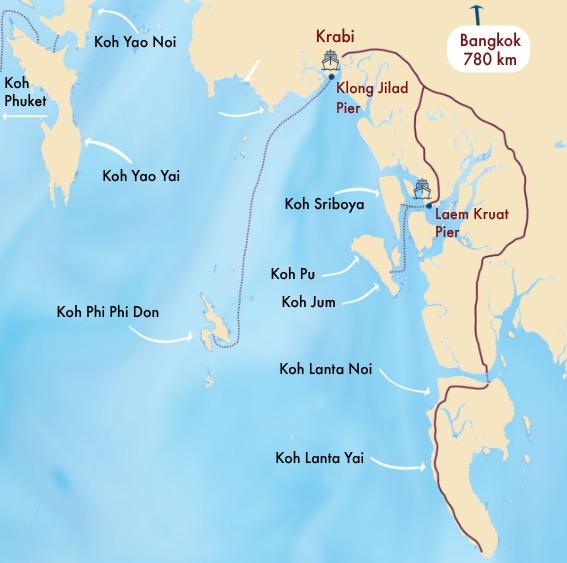
Notable Islands with Lodging
Most travellers to the region head straight from Phuket’s international airport to one of the island’s many beaches. As most of Phuket’s beaches are well developed, we will leave the island for more tranquil destinations on several of the region’s less developed islands.
1) Koh Lanta
Koh Lanta is actually two islands—the much less visited Koh Lanta Noi to the north and the popular crescent-shaped Koh Lanta Yai in the south. Koh Lanta Yai is well developed, in particular along its 20 kilometres (12 mi) of west coast beaches.
Further south, the resorts become fewer and the beaches, such as Klong Nin Beach, Nui Beach, and Bakantiang Beach, are more unspoiled. At the northernmost tip of the island, north of the Laem Kho Kwang Beach isthmus, a large white sandbank is exposed during low tide which is a pleasure to explore. Koh Lanta Yai has a variety of accommodation catering to all budgets.
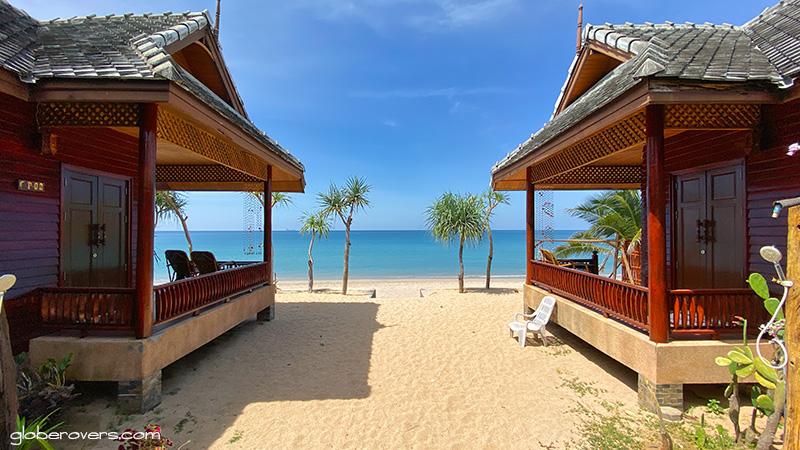
2) Koh Phi Phi Don
Koh Phi Phi, a small archipelago northwest of Koh Lanta, is world-renowned for its beautiful beaches and has become a Thai island celebrity with its spectacular beach photos splashed all over travel media.
Koh Phi Phi Don, the largest island in this archipelago, is the only inhabited island with most accommodation located at its isthmus.
Nearby is Koh Phi Phi Leh with its famous Maya Bay. Currently closed to tourists so the beach can recuperate after years of abuse, Maya Bay is expected to reopen soon.
Koh Phi Phi Don has some of the most popular and beautiful beaches, such as Ton Sai, Loh Dalum, Viking Beach, and Long Beach, all of which offer numerous resorts. However, a few less-visited beaches can be found tucked along its indented coast. While most conveniently reached by private long-tail boat, put on your hiking shoes and head into the jungle in search of these hidden gems, which include Nui Beach and nearby Laem Tong Beach at the island’s northern tip. South of Laem Tong Beach lies the beautiful Ba Kao Bay.
Further south is Phak Nam Bay, also known as Relax Bay, with its long white sand beach and two resorts, which is best reached by boat as this trail is quite challenging.

3) Koh Jum
Koh Jum, located to the north of Koh Lanta, is perhaps one of the quietest and most laid-back islands in this region. The island has a couple of fishing villages and a road suitable for a motorbike or bicycle. Koh Jum, the southern part of the island, is fairly flat, while Koh Pu, the northern part, has more hills.
Much of the west coast consists of long stretches of beach fringed by coconut trees where about 20 basic resorts are spread out along an eight-kilometre-long (5 mi) coast.
The roads are mostly tiny unpaved paths fit only for experienced bikers, so some beaches are more conveniently reached by boat. Among the best beaches from south to north are Freedom Beach, Andaman Beach, Golden Pearl Beach, Ao Si, Magic Beach, Ting Rai Beach, Sunset Beach, Coconut Beach, Banyan Bay and Rocky Beach. While not the most spectacular beaches in the region, they offer tranquillity, great sunsets, and long peaceful walks.
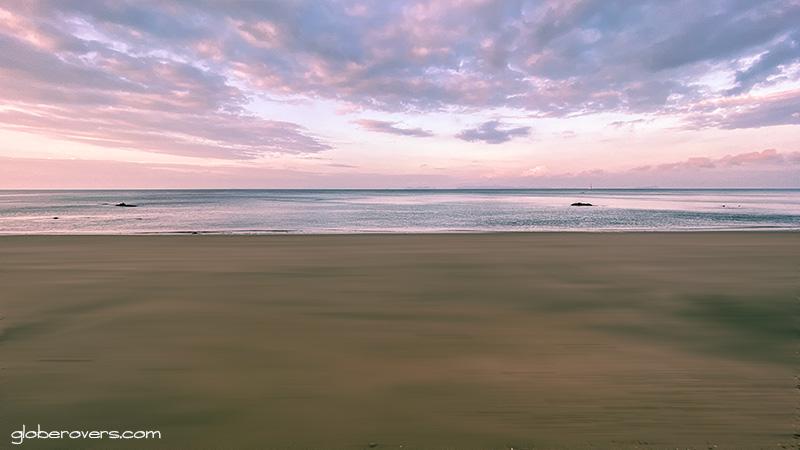
4) Koh Sriboya
Koh Sriboya, located directly north of Koh Jum, is quite similar but is even less visited by tourists. The island is home to fishermen and rubber-plantation workers, with dirt roads and footpaths connecting the small communities. While the island’s beaches are appealing, visitors come here to relax and become acquainted with the friendly islanders. A handful of basic resorts and homestays cater to the few travellers who venture here.
5) Koh Yao Yai
Koh Yao Yai or “big long island” is the larger of the two main islands in the Koh Yao Archipelago and measures almost 30 kilometres (18.6 mi) in length. A few resorts are located along the best beaches which are in the north-east and south-west, in particular Laem Had, Loh Jak, Loh Pared, and Ao Muang. Head to the far south to visit the photogenic Laem Laan fishing village.
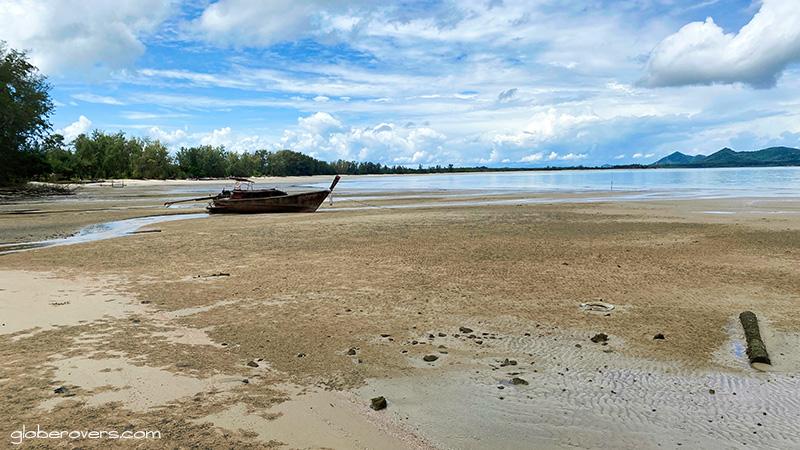
6) Koh Yao Noi
Located less than a kilometre to the north, Koh Yao Noi, or “little long island”, is quite similar in that the sea is not turquoise and pure white sand beaches are scarce. While the west coast has mangroves and rocky beaches, much of the east coast has wide sandy beaches including Pasai, Klong Jark and Tha Khao.
The most beautiful beaches are at the northeastern tip but are the private property of two resorts: TreeHouse Villas and the Paradise Resort. A tough hike further north leads to Mankei Bay which is flanked by impressive limestone karsts. The ever-vanishing path goes further to the “big tree” which, according to local beliefs, houses the spirit of a woman named Nang Da Kian in its broad trunk. Ao Kian Bay is at the northern tip of the island.

6) Small Islands close to Koh Phuket
Around Koh Phuket are several small islands such as Koh He, Koh Lon, Coconut Island, Koh Rang Yai and Koh Rang Noi, some of which offer upscale resorts.
The Unspoiled Beaches
When it comes to the most beautiful unspoiled beaches on islands with accommodation, Koh Phi Phi has it all, though it is not the only island with a special sandy spot for the discerning island enthusiast:
1) Nui Beach, Koh Phi Phi Don
This pristine beach is nestled in a tiny cove west of Lana Bay, in the north-west of Koh Phi Phi Don. The hiking trail from the island’s main beach, Loh Dalum, leads north-west past three viewpoints through the jungle until it reaches Lana Bay’s large, unfinished and abandoned resort. From the west side of the bay, follow an almost invisible path along the rocks, mostly underwater at high tide, to a small fishing community clinging to the narrow, rocky shore.
A short but steep path leads over the isthmus and down into a bay. The white sand beach is framed by tall limestone karsts and several impressive tall, rocky islands nearby. The water is crystal clear and great for snorkelling from the beach. Nui Beach is one of the most beautiful beaches in Thailand!

2) Laem Tong Beach, Koh Phi Phi Don
To the north-east of Nui Beach, a 2.6 kilometre-long (1.6 mi) narrow strip of land juts north-west into the sea. Along the east side, a small paved road follows Laem Tong Beach, a long stretch of white sand and clear water. Although partially lined with high-end resorts, it remains one of the most beautiful spots in this region.
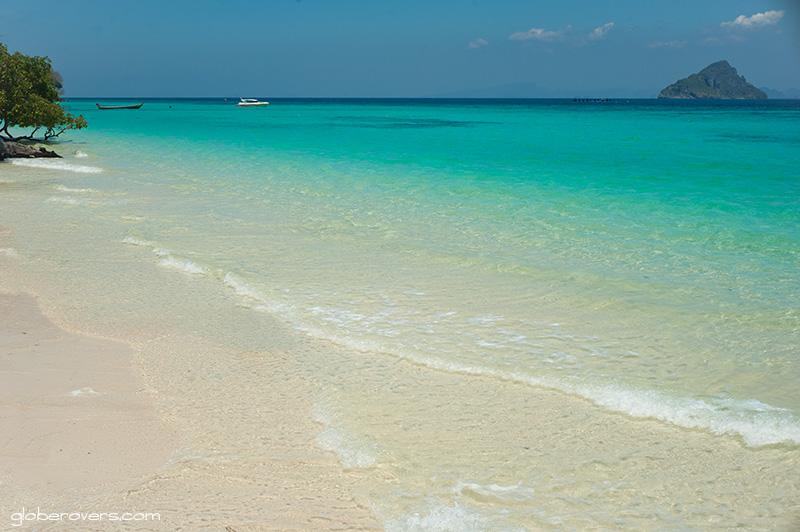
3) Loh Moo Dee Beach, Koh Phi Phi Don
Near the southeastern tip of Koh Phi Phi Don, and easily reached by footpath from the main ferry pier at Ton Sai via Viking Beach and Long Beach, lies Loh Moo Dee Beach. This 360-metre-long (1,190 ft) beach has no accommodation but is one of the region’s most impressive beaches lined with large shady trees and forests at both ends.
Near the beach, a rustic restaurant and bar offers refreshments but signs on the trees forbid visitors to enjoy their own food and drinks.
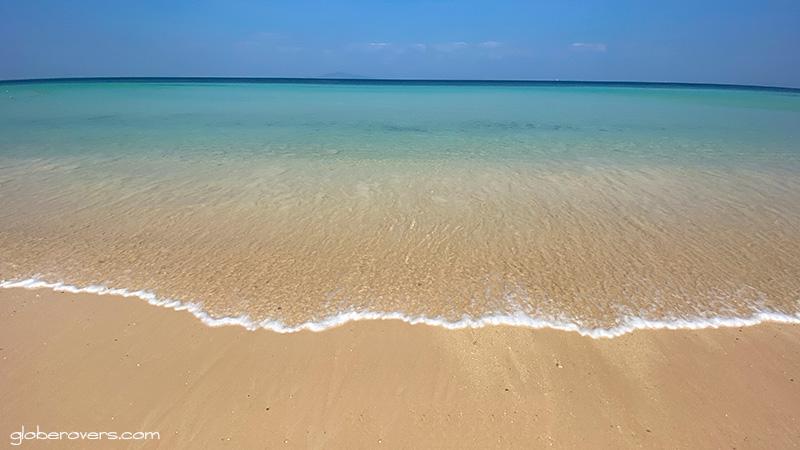
4) Laem Had Beach, Koh Yao Yai
Also known as the Koh Yao Yai Sandbank, the sparkling white spit of sand is located on Koh Yao Yai’s northern peninsula and stretches out towards the southern bay of its nearby sister island, Koh Yao Noi. Fringed by a thick grove of coconut trees, the sandbank is best explored during low tide when it is possible to walk over 400 metres (1,312 ft) out into the sea. If you visit around sunrise, you may be accompanied by thousands of tiny red crabs!
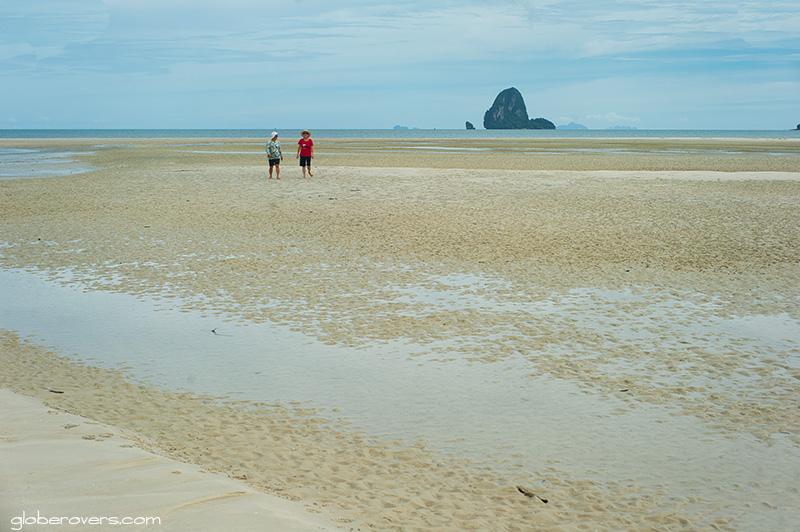
5) Mankei Bay Beach, Koh Yao Noi
Located on the far northeastern tip of the island lies the very secluded Mankei Bay and its beach. Getting here overland is quite a rewarding adventure. From Tha Khao Pier on the central east side of the island, follow a small road on motorbike or bicycle for about 7.5 kilometres (4.7 mi) to the high-security gates of the Paradise Koh Yao Resort. Just before the gates, a smaller path turns left then heads straight north. As this path is very small, it is best to walk the remaining 1.1 kilometres (0.68 mi) to Mankei Bay. Flanked by massive limestone rocks, it is a sight to behold!

6) Sunset Beach, Koh Jum
The island’s most scenic beach—and also one of the least visited—is located on its north-western side, with lots of white sand and clear water. The beach trees provide ample shade while the Sunset Beach Bungalows has a restaurant with cold drinks.
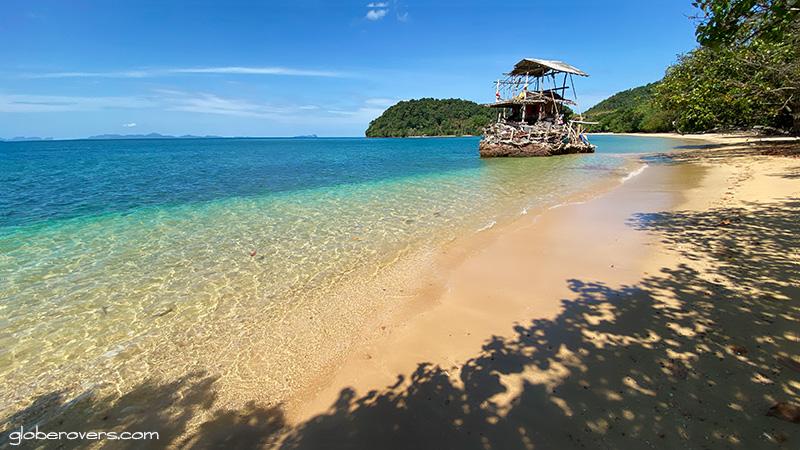
6) Nui Beach, Koh Lanta
Koh Lanta’s best beaches are on the southern half of the west coast. The jewel in the crown is Nui Beach, not to be confused with Nui Bay a kilometre further south. With only one place to stay, the Diamond Cliff Beach Restaurant at the northern end, this gorgeous beach is mostly deserted.

6) Beaches without accommodation
This region has many fabulous beaches on islands without accommodation, including the spectacular beaches at Bamboo Island (Koh Pai) and Moskito Island north of Laem Tong Beach at the northern tip of Koh Phi Phi Don.
Koh Haa means ‘five islands’ and unsurprisingly consists of five limestone islands located about an hour by boat to the west of Koh Lanta. The main island, Koh Haa Yai, was once a shelter for sea gypsies and local fishermen as its tiny natural harbour provided a safe haven from the monsoon storms. The islands are known for their white sand beaches, stunning karst formations, crystal clear water, and a shallow lagoon. The island has no accommodation but can be visited on day trips.
Practical Information
Getting there: Almost the entire region can be reached from Phuket Town on the southwest of Koh Phuket, which has several piers offering fast ferries, slow ferries, long-tail and speedboats.
Boats to Koh Yao Yai and Koh Yao Noi leave from Bang Rong Pier, 23 kilometres (14 mi) north of Phuket Town.
Koh Lanta, Koh Jum, Koh Sriboya, and mainland beaches such as Railay Beach and Ao Nang, are located closer to Krabi Town. Both Phuket and Krabi have airports and long-distance bus stations. Neither has a train station, though Krabi’s nearest train station is at Surat Thani, some 150 kilometres (93 mi) to the north. Buses, minivans, ferries, speedboats and private long-tail boats are plentiful across the region.
Getting around: As the only island linked by road to the mainland, Koh Phuket has highways and byways where car rental is common, while Koh Lanta requires a very short car crossing by ferry.
Koh Lanta has good roads along both the west and east coasts. The other islands in this region have mostly paved and unpaved paths fit only for motorbikes and bicycles. Koh Phi Phi is mostly inaccessible by wheels.
Sleep, eat and drink: The islands of Phuket, Lanta and Phi Phi are the most developed with plentiful accommodation and restaurants catering to all budgets, from inexpensive to super-luxury.
Tourist facilities are less abundant or grandiose on the other islands. Koh Sriboya is the least developed island, with just a few budget places to stay and eat.

Links to all island regions of Thailand
Overview and map of Thailand’s Islands
Region 1: Southern Andaman (Koh Lipe area)
Region 2: Lower Central Andaman (Koh Mook area)
Region 3: Upper Central Andaman (Koh Lanta area) – YOU ARE HERE
Region 4: Northern Andaman (Koh Phayam area)
Region 5: Central Gulf of Thailand (Koh Samui area)
Region 6: Eastern Gulf of Thailand (Koh Chang area)
Region 7: Northern Gulf of Thailand (Koh Samet area)
10 Best Beaches on Thailand’s Islands
Notes when reading the details in each region
- In the Thai language, “koh” means “island”, so the correct way to refer to the island of Phuket, for example, is “Koh Phuket” rather than “Koh Phuket Island”. “Ao” means “beach”, so “Ao Nang” means “Nang Beach”. “Mu koh” means “archipelago”, so “Mu Koh Ang Thong” means “Ang Thong Archipelago” .
- Some of Thailand’s islands have the same or similar names. Some examples include Koh Chang in the Gulf of Thailand, and Koh Chang Noi along the northern Andaman Coast; and Koh Ngam Yai and Koh Ngam Noi near the town of Chumphon, which is far from Koh Ngam at the southeastern tip of Koh Chang near Cambodia.
- Covid-19 is decimating the tourist infrastructure on Thailand’s islands. Most tourist services, including accommodation and transport services, available pre-Covid are not currently accessible, and may not be restored for a while.
- While some islands can be reached by public ferries, speedboats and long-tail boats, some are only accessible by private boat rental.
- Much effort has been made to provide information that is as accurate as possible, but please do your own extensive research to get the latest information.
- This article focuses on the best beaches on islands with accommodation, though islands managed by the National Parks offering tents for rent are also included. We also include noteworthy islands and beaches of interest with no accommodation.
- This article is not intended as a comprehensive guide to all islands of Thailand.
☛ Read more: Blog posts of Thailand

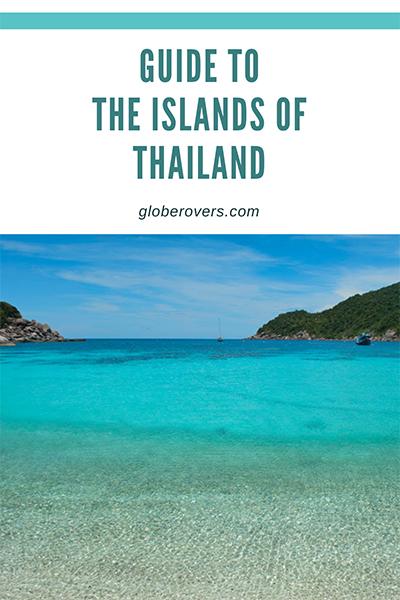
Additional Reading
CNN Traveler: The 11 best islands in Thailand
Top 10 Best Thai Islands that need to be on your bucket list

Blog post and photos by Peter who has been travelling almost full-time since 2005 and has been to over 122 countries. He visited several countries, such as Japan, more than 20 times. Peter is Editor-in-Chief and Publisher of GlobeRovers Magazine, an independent travel magazine focused on intrepid destinations.
